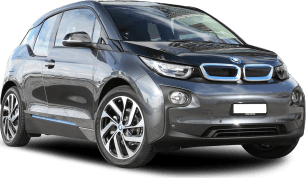Built around a carbon-fibre reinforced plastic (CFRP) tub, the i3s is ultra-light (for a battery-electric vehicle), super strong, and unlike anything else on the road.
At just over 4.0m long, close to 1.8m wide, and a fraction under 1.6m tall, the i3s is compact, upright, and boxy. A classically polarising design, with some crossing the street to avoid it, and others (like me) loving its unique proportions and stand-out styling.
The nose is tall, short and upright, with the distance from the base of the front windscreen to the front axle (car designers call it the ‘dash-to-axle ratio’) unusually short.
That’s because the electric motor sits in the back of the car driving the rear wheels, with only a small front boot compartment required to house charging cables and other bits and pieces.
Despite the lack of anything of substance behind it, BMW’s signature ‘kidney grille’ is present and accounted for, with swoopy LED headlights (and DRLs) either side. Our test car’s ‘Fluid Black’ finish with ‘i Blue’ highlights dialed up the little car’s charismatic personality.
One of the i3’s most impressive party tricks is its counter-opening ‘clamshell’ doors, and the engineering trickery used to create a B-pillar free side opening (including the strength of the carbon body structure) means the high window line follows a jagged path from front to back, the rearmost hatch windows shrinking the rear glass area appreciably.
The i3s’s standard 20-inch (dual) five-spoke alloy rims, although slightly wider in this performance model, are alarmingly skinny. But taking the car’s relatively light weight (1245kg) and urban-centric purpose into consideration, the narrow, low-rolling resistance rubber makes sense.
With the roofline and sides of the car tapering distinctly towards the back, the rear view is suitably idiosyncratic, highlighted by flush-fit, vaguely U-shaped LED tail-lights.
The hatch window is small, and the bumper sits high to marry with the load space floor sitting on top of the motor and transmission.
And when it comes to moving inside, BMW offers a choice of three ‘interior worlds - ‘Loft’, ‘Lodge’, and ‘Suite’ - featuring renewable natural fibres, recycled plastics, naturally tanned leather, and open-pore wood (sourced from 100 per cent Forest Stewardship Council-certified forestry).
But irrespective of where everything comes from, the end result is inviting, comfortable and sub-zero cool. Our car’s ‘Suite’ interior was combined with ‘Oak dark matt’ wood, and ‘Vernasca’ brown leather to stunning effect.
A tunnel-free floor, gently curved dash and digital screens for instruments and media let you know you’re in something different and special. It might be six years old, but the i3 still feels contemporary and distinctive.

